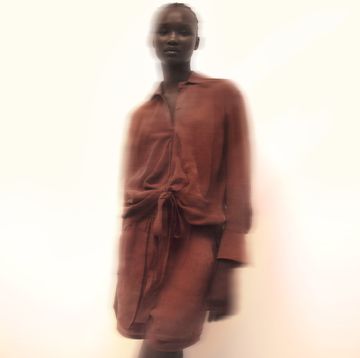We’re by the ocean, but it’s not just any beach. It’s Jacob Riis Park, where queer people flock to get away from city noise and flaunt our bodies, curves, bulges, rolls, scars... everything that makes us beautiful.
“It’s the place where I’ve seen more Chromat in the wild than any place on earth,” says Becca McCharen-Tran, designer of the brand.
Bodies of water have always been a source of power for us. In New York City, those who aren’t at the beach often hang at the piers along the Hudson River. Water is a source of life.
As a model for this collection, I am walking alongside people of different sizes, ancestries, and abilities. We are living embodiments of our lineage carried forward. In these times, colonization has severed us from our past selves, where many of us were spiritual leaders, historians, shamans, mediums—we were respected for the knowledge we brought to our people.
This collection, titled “Collective Opulence Celebrating Kindred,” demands that the world witness us. We are beautiful and unchanged. We are beautiful in all the ways we seek to transform, too.
“As trans and gender nonconforming, non-binary, intersex people, we deserve to feel pleasure and feel sexy, like hot and delicious, as huge meals and little snacks,” says artist and filmmaker Tourmaline, who collaborated with McCharen-Tran on the spring/summer 2022 collection.
Runway shows have begun to diverge from thin, white, and tall because of the many years activists spent trying to shift entrenched cultural norms. Plus-size models are only sprinkled into runway shows, even though the majority of American women are plus-size in the eyes of the fashion industry. Chromat has consistently showcased the full scope of humanity, in all of our abilities, genders, and body types.
“When we used to ask our friends to model, it was so shocking. Now it’s the bare minimum with brands,” says McCharen-Tran. “With this collection, it’s also a jump forward in how trans bodies can be envisioned.”
I have spent years strategizing how to warp my body in a way that creates safety for me. At the beach, especially, where our bodies are on full display, trans women are constantly wracked with danger. What makes it all the more heartbreaking is that my ancestors lived by the Pacific, in central Vietnam. They would greet the day at sunrise to be in the ocean. It was a source of food, play, and solace. The ocean is home. But it was made to be dangerous to me after many centuries of criminalization and targeting of gender-variant people.
What’s remarkable about Chromat’s commitment to showcasing all kinds of bodies is the way it allows us to experience a future we’ve always deserved. For a moment, we are time-traveling together. We are bringing the future to us.
When I nervously slipped on the one-piece, made with a pouch for people who have penises, I thought of all the times I had to hide and pretend that I had a body that wasn’t mine. This time, I was given permission to not only come as I am, but celebrate myself and those who share my experience. I was asked to let myself breathe and take pleasure in just being me, alongside my community.
Hair and makeup was intended to emulate archival photos of Black trans icon Marsha P. Johnson, with heavy blush on her cheeks and flowers throughout her hair.
“So much of Marsha’s legacy was around fashion,” says Tourmaline. “Marsha’s actions were in rebellion to the morality of the state, using fashion to control trans bodies, like with the anti-crossdressing laws police enforced to raid Stonewall. Those laws have an aesthetic level of violence.”
The runway show was a ritual in remembrance of the people who led the way for us to be able to be all of who we are.
When we listen to the ocean, we are listening to ourselves. If we listen closely, we can hear the laughs of Marsha P. Johnson, the shouts of Sylvia Rivera in between drags of her cigarette. We can hear the clacking heels of Octavia St. Laurent.
As writer and scholar Alexis Pauline Gumbs teaches us, water holds memories through sound waves that live inside the ebb and flow. All of this history is stored and carried along the Hudson, down to where the river meets the coastline of the Rockaways. And from there, it travels to the oceans that carry our trauma and our lineage. Here we are, unabashed, in each other’s arms, in their name, in their memory.















